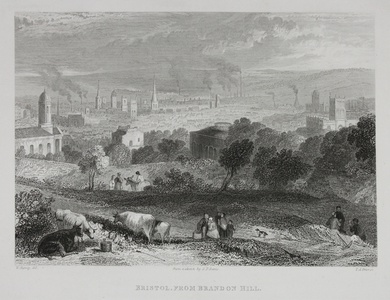| Method | Steel engraving |
| Artist | Thomas Abiel Prior after William Harvey |
| Published | [c. 1850] |
| Dimensions | Image 138 x 195, Sheet 187 x 271 mm |
| Notes |
A view of the city of Bristol, from Brand-on-Hill. Smoking factory chimneys interspersed with church spires dot the cityscape, firmly placing this work within the era of industrialisation. Figures and cattle in the foreground. Thomas Abiel Prior (1809 - 1886) was an English engraver. His early work was produced for the publishers Henry Fisher and George Virtue. After Thomas Allom (1804-72) he engraved two plates each for T. Rose's 'Durham and Northumberland' (London, 1832), and 'Counties of Chester' (London, 1836); two plates each for Dr William Beattie's 'Scotland Illustrated' (London, 1838), and R. Walsh's 'Constantinople' (London, 1838-40); eleven for E. W. Brayley's 'A Topographical History of Surrey' (London, 1841-2); 'Bazaar of the Fig Tree, Algiers' after Allom for G. N. Wright's 'The Shores and Islands of the Mediterranean' (London, 1840); and six for G. N. Wright's 'China' (London, 1843). After William Henry Bartlett he engraved 'Ber-el-Kamar' for John Carne's 'Syria' (London, 1836-8), two plates for Nathaniel Parker Willis's 'American Scenery' (London, 1840), and three for G. N. Wright's 'Rhine, Italy and Greece' (London, 1841-2). In 1846 Prior bought from J. M. W. Turner the drawing of 'Heidelberg' and published the engraving on copper (1844), which established his reputation. It was re-engraved on steel for the 'Art Journal' (1864) and was re-issued in R. W. Wornum's 'Turner Gallery' (1878). He engraved 14 plates for the 'Art Journal' between 1850 and 1871. He engraved 'Whittington' after Frederick Newenham as the Art Union of Glasgow's presentation plate for 1849. His last engraving was 'The Fighting Temeraire' after Turner, completed in September 1866, some six weeks before his death. About 1860 he moved to Calais to be near his son and spent most of his time teaching drawing in the local schools. William Harvey (13 July 1796 - 1866) was an English engraver and designer. At the age of 14, he was apprenticed to Thomas Bewick, who described him as one 'who both as an engraver & designer, stands pre-eminent'. He engraved many blocks for Bewick's 'Aesop's Fables' (1818). Harvey moved to London in 1817, studying drawing with Benjamin Haydon, and anatomy with Charles Bell. In 1821, he engraved for Haydon on wood the Assassination of L. S. Dentatus. This was probably the then most ambitious block which had been cut in England. Harvey switched to design in around 1822. |
| Framing | unmounted |
| Price | £50.00 |
| Stock ID | 45720 |

